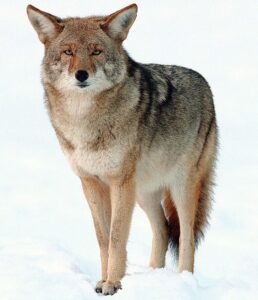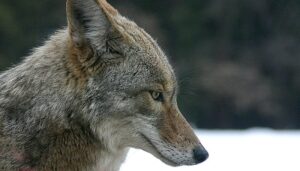In Alaska the wolf is still top dog but I have to admit, my Wyoming roots couldn’t help but enjoy the surprising chorus of canine voices I heard the other night from what sounded like a pack of coyotes. Two coyotes howling unison can create the illusion of a dozen or more preforming in concert. Coyotes (Canis latrans) are relative newcomers to this state and a person still has a better chance of seeing wolves than coyotes here. Where wolves are abundant, coyotes make themselves scarce. The elimination of wolves from their traditional ranges in the Lower 48 has contributed to the expansion of coyote populations there. Coyotes resemble small slender wolves and average 22 to 33 pounds, about one-third the weight of wolves. They vary in color in different parts of their range but typically are coarsely grizzled, buff gray. The bushy tail is usually blackish above and pale buff underneath with a black tip. The history of this predator in America is fascinating. The coyote is one of the few mammals that has succeeded in extending its territory, despite the spread of civilization and the extraordinary attempt by man to exterminate it. In North America, the coyote used to be confined to the Great Plains of the American West as far as the limits of the forests. Today, its range extents from Alaska to Costa Rica and from the Pacific to the Atlantic.
Like the wolf, the coyote¹s best known trait is its cry and bark. Its main cry includes both yelping and howling. It makes itself heard at any time from sunset to sunrise, especially at dusk and dawn, earning its name as “song dog”. The howling seems to be a means of communication. The cry invariably brings a reply, then a sort of commentary followed by another prolonged cry and finally, a volley of raucous yelpings. The coyote has a playful kind of carefree spirit. It is fond of playing with other coyotes and even plays with its prey before devouring it. The coyote¹s senses of hearing and smell are so well developed that a sudden odor or noise can make it change its course in mid-step. It is a remarkably hard runner with incredible stamina. Swift, tough and wily, the coyote has only 2 known weaknesses: it sleeps heavily and looks back while fleeing, both of which the savvy hunter can take advantage of. Coyotes are, on the whole, monogamous, and couples remain together for many years. The female will breed at one year of age; the male breeds when it is slightly older.
During mating season, males compete for females¹ favors, staging howling contests that sometimes end in battle. The mating takes place in early spring and gestation lasts from 60-63 days. The pups are born in a den dug into a hillside or steep bank. Sometimes dens are enlarged marmot or squirrel burrows. To be on the safe side, the female prepares alternative lodgings to enable her family to move to another refuge should trouble occur. On the average 5 to 7 pups are born, they have fine brown fur and their eyes remain closed for the first 8 or 9 days. At about three weeks of age, the pups begin to romp around and will venture outside. Should some enemy come too close, the mother utters a special warning cry, then lures the enemy away by faking a limp, intending to double back and shift the cubs to another den should she think it necessary. The male leaves the female before she starts to whelp. He prowls around and brings food to the entrance. Weaning takes place about one month after the birth; afterwards the mother regurgitates half-digested food for the pups. Two months after the cubs are born, the father returns to stay. The parents then take the cubs out to teach them how to hunt. When fall comes, the young coyotes must leave their parents to claim their own territory. They face many dangers; predators, accidents, traps and firearms take their toll of young. Man¹s attitude towards the coyote varies according to where he lives, his livelihood, and his contact with the animal. It has always been difficult to convince domestic livestock owners of the coyote¹s rightful place in the fauna. However, grain producers bless the coyote for the natural control it provides over rodents. Gradually the attitude is changing and people are coming to realize that the coyote is more valuable as a scavenger and predator of rodents, than it is harmful to livestock. The coyote has adapted to civilization. The more it is harassed, the more it proliferates. Its extraordinary cleverness enables it to outwit man, the coyote¹s main predator. It is very prolific and being omnivorous, it will eat just about anything in any environment. Man has harassed it into finding new environments, has driven away the wolf, and by cutting out the forests, has opened new territories to the coyote. Judging from its past history the coyote is one mammal which will probably always be with us.





